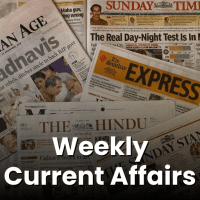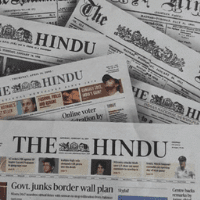Current Affairs Exam > Current Affairs Questions > What is the percentage of GDP targeted by the...
Start Learning for Free
What is the percentage of GDP targeted by the 15th Finance Commission for Health Expenditure by including the health care scenario for the first time in India?
- a)1.2%
- b)1.8%
- c)2.1%
- d)2.5%
- e)2.7%
Correct answer is option 'C'. Can you explain this answer?
Verified Answer
What is the percentage of GDP targeted by the 15th Finance Commission ...
The Fifteenth Finance Commission (XVFC) led by Chairman Nand Kishore (NK) Singh submitted its Report titled “Finance Commission in Covid Time” for the period of five years from 2021-22 to 2025-26 to the President of India Ram Nath Kovind. It should be noted that this is the first time that a chapter on the health care scenario of the country is introduced along with recommendations in order to boost public-health spending in a post-pandemic era.
The target is that the Centre alone should be able to spend at least 2.1% of GDP (Gross Domestic Product) on health in the next five years.
The target is that the Centre alone should be able to spend at least 2.1% of GDP (Gross Domestic Product) on health in the next five years.
Most Upvoted Answer
What is the percentage of GDP targeted by the 15th Finance Commission ...
The 15th Finance Commission of India has targeted a health expenditure of 2.1% of the GDP. This marks the first time that the health care scenario has been included in India's finance commission recommendations.
Explanation:
1. Health Expenditure in Finance Commission Recommendations:
- The Finance Commission is a constitutional body in India that recommends the distribution of financial resources between the central government and the state governments.
- The 15th Finance Commission, headed by N.K. Singh, was constituted in 2017 and its recommendations cover the period from 2021 to 2026.
- In its recommendations, the commission has targeted a health expenditure of 2.1% of the GDP.
- This means that the government should allocate 2.1% of the total value of goods and services produced in the country towards health care.
2. Significance of Including Health Expenditure:
- The inclusion of health expenditure in the finance commission recommendations is a significant step towards prioritizing and improving the health care system in India.
- Historically, health expenditure has not been given adequate attention, leading to challenges in providing quality health care services to the population.
- By specifically targeting a percentage of the GDP for health expenditure, the commission aims to ensure that sufficient funds are allocated to strengthen the health care infrastructure, improve access to health services, and enhance the overall health outcomes in the country.
3. Rationale behind 2.1% Target:
- The commission arrived at the target of 2.1% after considering various factors, including the current state of the health care system, the health needs of the population, and the resource availability.
- It is important to note that the commission's recommendation is not a one-size-fits-all solution, but rather a benchmark that can guide the government in allocating resources towards health care.
- The target of 2.1% is based on the commission's assessment of the resources required to address the existing health challenges and achieve the desired health outcomes in the country.
4. Implications and Challenges:
- Achieving the target of 2.1% health expenditure will require increased budgetary allocations to health care by both the central and state governments.
- This will require a coordinated effort to ensure that the funds are effectively utilized and result in tangible improvements in the health care system.
- The commission's recommendation also highlights the need for reforms in health financing, governance, and service delivery to optimize the utilization of resources and enhance the efficiency of the health care system.
In conclusion, the 15th Finance Commission of India has recommended a health expenditure of 2.1% of the GDP, marking the inclusion of health care in its recommendations for the first time. This target is aimed at improving the health care system in the country and addressing the existing health challenges. Achieving this target will require increased budgetary allocations and reforms in health financing and service delivery.
Explanation:
1. Health Expenditure in Finance Commission Recommendations:
- The Finance Commission is a constitutional body in India that recommends the distribution of financial resources between the central government and the state governments.
- The 15th Finance Commission, headed by N.K. Singh, was constituted in 2017 and its recommendations cover the period from 2021 to 2026.
- In its recommendations, the commission has targeted a health expenditure of 2.1% of the GDP.
- This means that the government should allocate 2.1% of the total value of goods and services produced in the country towards health care.
2. Significance of Including Health Expenditure:
- The inclusion of health expenditure in the finance commission recommendations is a significant step towards prioritizing and improving the health care system in India.
- Historically, health expenditure has not been given adequate attention, leading to challenges in providing quality health care services to the population.
- By specifically targeting a percentage of the GDP for health expenditure, the commission aims to ensure that sufficient funds are allocated to strengthen the health care infrastructure, improve access to health services, and enhance the overall health outcomes in the country.
3. Rationale behind 2.1% Target:
- The commission arrived at the target of 2.1% after considering various factors, including the current state of the health care system, the health needs of the population, and the resource availability.
- It is important to note that the commission's recommendation is not a one-size-fits-all solution, but rather a benchmark that can guide the government in allocating resources towards health care.
- The target of 2.1% is based on the commission's assessment of the resources required to address the existing health challenges and achieve the desired health outcomes in the country.
4. Implications and Challenges:
- Achieving the target of 2.1% health expenditure will require increased budgetary allocations to health care by both the central and state governments.
- This will require a coordinated effort to ensure that the funds are effectively utilized and result in tangible improvements in the health care system.
- The commission's recommendation also highlights the need for reforms in health financing, governance, and service delivery to optimize the utilization of resources and enhance the efficiency of the health care system.
In conclusion, the 15th Finance Commission of India has recommended a health expenditure of 2.1% of the GDP, marking the inclusion of health care in its recommendations for the first time. This target is aimed at improving the health care system in the country and addressing the existing health challenges. Achieving this target will require increased budgetary allocations and reforms in health financing and service delivery.

|
Explore Courses for Current Affairs exam
|

|
Similar Current Affairs Doubts
What is the percentage of GDP targeted by the 15th Finance Commission for Health Expenditure by including the health care scenario for the first time in India?a)1.2%b)1.8%c)2.1%d)2.5%e)2.7%Correct answer is option 'C'. Can you explain this answer?
Question Description
What is the percentage of GDP targeted by the 15th Finance Commission for Health Expenditure by including the health care scenario for the first time in India?a)1.2%b)1.8%c)2.1%d)2.5%e)2.7%Correct answer is option 'C'. Can you explain this answer? for Current Affairs 2025 is part of Current Affairs preparation. The Question and answers have been prepared according to the Current Affairs exam syllabus. Information about What is the percentage of GDP targeted by the 15th Finance Commission for Health Expenditure by including the health care scenario for the first time in India?a)1.2%b)1.8%c)2.1%d)2.5%e)2.7%Correct answer is option 'C'. Can you explain this answer? covers all topics & solutions for Current Affairs 2025 Exam. Find important definitions, questions, meanings, examples, exercises and tests below for What is the percentage of GDP targeted by the 15th Finance Commission for Health Expenditure by including the health care scenario for the first time in India?a)1.2%b)1.8%c)2.1%d)2.5%e)2.7%Correct answer is option 'C'. Can you explain this answer?.
What is the percentage of GDP targeted by the 15th Finance Commission for Health Expenditure by including the health care scenario for the first time in India?a)1.2%b)1.8%c)2.1%d)2.5%e)2.7%Correct answer is option 'C'. Can you explain this answer? for Current Affairs 2025 is part of Current Affairs preparation. The Question and answers have been prepared according to the Current Affairs exam syllabus. Information about What is the percentage of GDP targeted by the 15th Finance Commission for Health Expenditure by including the health care scenario for the first time in India?a)1.2%b)1.8%c)2.1%d)2.5%e)2.7%Correct answer is option 'C'. Can you explain this answer? covers all topics & solutions for Current Affairs 2025 Exam. Find important definitions, questions, meanings, examples, exercises and tests below for What is the percentage of GDP targeted by the 15th Finance Commission for Health Expenditure by including the health care scenario for the first time in India?a)1.2%b)1.8%c)2.1%d)2.5%e)2.7%Correct answer is option 'C'. Can you explain this answer?.
Solutions for What is the percentage of GDP targeted by the 15th Finance Commission for Health Expenditure by including the health care scenario for the first time in India?a)1.2%b)1.8%c)2.1%d)2.5%e)2.7%Correct answer is option 'C'. Can you explain this answer? in English & in Hindi are available as part of our courses for Current Affairs.
Download more important topics, notes, lectures and mock test series for Current Affairs Exam by signing up for free.
Here you can find the meaning of What is the percentage of GDP targeted by the 15th Finance Commission for Health Expenditure by including the health care scenario for the first time in India?a)1.2%b)1.8%c)2.1%d)2.5%e)2.7%Correct answer is option 'C'. Can you explain this answer? defined & explained in the simplest way possible. Besides giving the explanation of
What is the percentage of GDP targeted by the 15th Finance Commission for Health Expenditure by including the health care scenario for the first time in India?a)1.2%b)1.8%c)2.1%d)2.5%e)2.7%Correct answer is option 'C'. Can you explain this answer?, a detailed solution for What is the percentage of GDP targeted by the 15th Finance Commission for Health Expenditure by including the health care scenario for the first time in India?a)1.2%b)1.8%c)2.1%d)2.5%e)2.7%Correct answer is option 'C'. Can you explain this answer? has been provided alongside types of What is the percentage of GDP targeted by the 15th Finance Commission for Health Expenditure by including the health care scenario for the first time in India?a)1.2%b)1.8%c)2.1%d)2.5%e)2.7%Correct answer is option 'C'. Can you explain this answer? theory, EduRev gives you an
ample number of questions to practice What is the percentage of GDP targeted by the 15th Finance Commission for Health Expenditure by including the health care scenario for the first time in India?a)1.2%b)1.8%c)2.1%d)2.5%e)2.7%Correct answer is option 'C'. Can you explain this answer? tests, examples and also practice Current Affairs tests.

|
Explore Courses for Current Affairs exam
|

|
Signup for Free!
Signup to see your scores go up within 7 days! Learn & Practice with 1000+ FREE Notes, Videos & Tests.


























